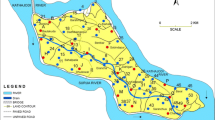Abstract
The main aim of this research article is to compare the different algorithms of artificial neural networks and for prediction of groundwater-level feed-forward back propagation networks were applied for Baberu Block of Banda Districts, which comes under Yamuna River Basin. An optimal design is completed with four different algorithms such as Levenberg–Marquardt, Gradient Descent, Scaled Conjugate Gradient and Bayesian Regularization. The data regarding training of ANN is obtained from recharge and discharge data while groundwater level data was used for output layer. After comparison with different algorithms, the best algorithm is Levenberg–Marquardt algorithm.
Access this chapter
Tax calculation will be finalised at checkout
Purchases are for personal use only
Similar content being viewed by others
References
Selvam S (2012a) use of remote sensing and GIS techniques for land use and land cover mapping of tuticorin coast, Tamil Nadu. Univ J Environ Res Tech V.2(4):233–241
Todd DK, Mays LW (2005) Groundwater hydrology, 3rd edn. Wiley, Hoboken
UNESCO (2015) Water for a sustainable world. Facts and figures. The United Nations World Water Development Report 2015. United Nations World Water Assessment Programme Programme Office for Global Water Assessment, Division of Water Sciences, Perugia, Italy, p 12
Pandey VP, Kazama F (2011) Hydrogeologic chararacteristics of groundwater aquifers in Kathmandu Valley, Nepal. Environ Earth Sci 62(8):1723–1732
Pandey VP, Kazama F (2012) Groundwater storage potential in the Kathmandu Valley’s shallow and deep aquifers. In: Shrestha S, Pradhananga D, Pandey VP (eds) Kathmandu valley groundwater outlook, AIT/SEN/CREEW/ICRE-UY, pp 31–38
Pandey VP, Shrestha S, Kazama F (2012) Groundwater in the Kathmandu Valley : development dynamics, consequences and prospects for sustainable management. European Water 37:3–14
Pandey VP, Shrestha S, Kazama F (2012) A framework for measuring groundwater sustainability. Environ Sci Policy 14(4):396–407
Matej G, Isabelle W, Jan M (2007) Regional groundwater model of north-east Belgium. J Hydrol 335:133–139
Pool DR, Blasch KW, Callegary JB, Leake SA, Graser LF (2011) Regional groundwater-flow model of theredwall-muav, coconino, and alluvial basin aquifer systems of Northern and Central Arizona: USGS Scientific Investigation Report 2010–5180, v. 1.1, 101
Yao Y, Zheng C, Liu J, Cao G, Xiao H, Li H, Li W (2015) Conceptual and numerical models for groundwater flow in an arid inland river basin. Hydrol Proc 29:1480–1492
ASCE Task Committee (2000) Artificial neural networks in hydrology—I: preliminary concepts. J Hydrol Eng ASCE 5(2):115–123
ASCE Task Committee (2000) Artificial neural networks in hydrology—II: hydrologic applications. J Hydrol Eng ASCE 5(2):124–137
Gobindraju RS, Ramachandra Rao A (2000) Artificial neural network in hydrology. Kluwer, Dordrecht
Aziz ARA, Wong KFV (1992) Neural network approach to the determination of aquifer parameters. Ground Water 30(2):164–166
Balkhair KS (2002) Aquifer parameters determination for large diameter wells using neural network approach. J Hydrol 265(1):118–128
Garcia LA, Shigdi A (2006) Using neural networks for parameter estimation in ground water. J Hydrol 318(1–4):215–231
Hong YS, Rosen MR (2001) Intelligent characterization and diagnosis of the groundwater quality in an urban fractured-rock aquifer using an artificial neural network, Urban Water 3(3):193–204
Karahan H, Ayvaz MT (2008) Simultaneous parameter identification of a heterogeneous aquifer system using artificial neural networks. Hydrogeol J 16:817–827
Samani M, Gohari-Moghadam M, Safavi AA (2007) A simple neural network model for the determination of aquifer parameters. J Hydrol 340:1–11
Shigdi A, Garcia LA (2003) Parameter estimation in groundwater hydrology using artificial neural networks. J Comput Civ Eng ASCE 17(4):281–289
Kuo V, Liu C, Lin K (2004) Evaluation of the ability of an artificial neural network model to assess the variation of groundwater quality in an area of blackfoot disease in Taiwan. Water Res 38(1):148–158
Milot J, Rodriguez MJ, Serodes JB (2002) Contribution of neural networks for modeling trihalomethanes occurrence in drinking water. J Water Resour Plan Manage ASCE 128(5):370–376
Maier HR, Dandy GC (1998) Understanding the behavior and optimizing the performance of back- propagation neural networks: an empirical study .Environ Modell Softw 13:179–191
Anctil F, Perrin C, Andressian V (2004) Impact of the length of observed records on the performance of ANN and of conceptual parsimonious rainfall- runoff forecasting models. Environ Model Softw 19(4):357–368
Haykin S (1999) Neural networks :a comprehensive foundation. 2nd ed. Prentice Hall, New Jersey, p 823
Moller MF (1993) A scaled conjugate gradient algorithm for fast supervised learning. Neural Netw 6(4):525–533
Karmokar BC, Mahmud MP, Siddique MK, Nafi KW, Kar TS (2012) Touchless written english characters recognition using neural network. Int J Comput Org Trends 2(3):80–84
Acknowledgements
The authors would like to specially thank to the Banda irrigation department to provide all necessary data.
Author information
Authors and Affiliations
Corresponding author
Editor information
Editors and Affiliations
Rights and permissions
Copyright information
© 2021 The Author(s), under exclusive license to Springer Nature Singapore Pte Ltd.
About this paper
Cite this paper
Asghar Moeeni, S., Sharif, M., Ahsan, N., Iqbal, A. (2021). Simulation of Groundwater level by Artificial Neural Networks of Parts of Yamuna River Basin. In: Bajpai, M.K., Kumar Singh, K., Giakos, G. (eds) Machine Vision and Augmented Intelligence—Theory and Applications. Lecture Notes in Electrical Engineering, vol 796. Springer, Singapore. https://doi.org/10.1007/978-981-16-5078-9_32
Download citation
DOI: https://doi.org/10.1007/978-981-16-5078-9_32
Published:
Publisher Name: Springer, Singapore
Print ISBN: 978-981-16-5077-2
Online ISBN: 978-981-16-5078-9
eBook Packages: Computer ScienceComputer Science (R0)




